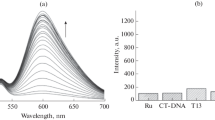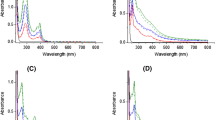Abstract
A new ruthenium complex with a dppz-like ligand pyidppz, [Ru(bpy)2(pyidppz)]2+ (pyidppz = 2-(pyridine-2-yl)imidazo-[4,5-b]dipyrido-[3,2-a:2′,3′-c]phenazine) has been synthesized and characterized by ES-MS, elemental analysis, 1H NMR. Intercalative mode of the complex bound to calf thymus DNA has been supported by different spectroscopic methods and viscosity measurements. The introduction of phenazine unit may be one of the main reasons for the weak emission of Ru(II) complex in aqueous solution. Under irradiation, this complex can efficiently cleave DNA. And the photocleavage reaction of the complex is found to be inhibited in the presence of singlet oxygen scavenger. Topoisomerase inhibition and DNA strand passage assay demonstrated that [Ru(bpy)2(pyidppz)]2+ and its parent complex [Ru(bpy)2(pyip)]2+ (pyip = 2-(pyridine-2-yl)imidazo[4,5-f][1,10]phenanthroline) can act as efficient catalytic inhibitor of DNA topoisomerase I.









Similar content being viewed by others
References
Friedman AE, Chambron JC, Sauvage JP, Turro NJ, Barton JK (1990) A molecular light switch for DNA: Ru(bpy)2(dppz)2+. J Am Chem Soc 112:4960–4962
Ling LS, He ZH, Song GW, Zeng YE, Wang C, Bai CL, Chen XD, Shen P (2001) High sensitive determination of DNA by use of molecular “light switch” complex of Ru(phen)2(dppx)2+. Anal Chim Acta 436:207–214
Ling LS, He ZK, Chen F, Zeng YE (2003) Single-mismatch detection using nucleic acid molecular ‘light switch’. Talanta 59:269–275
DeSilva AP, McClenaghan ND (2004) Molecular-scale logic gates. Chem Eur J 10:574–586
Jiang Y, Fang X, Bai C (2004) Signaling aptamer/protein binding by a molecular light switch complex. Anal Chem 76:5230–5235
Tysoe SA, Kopelman R, Schelzig D (1999) Flipping the molecular light switch Off: formation of DNA-bound heterobimetallic complexes using Ru(bpy)2tpphz2+ and transition metal ions. Inorg Chem 38:5196–5197
Hartshorn RM, Barton JK (1992) Novel dipyridophenazine complexes of ruthenium (II):exploring luminescent reporters of DNA. J Am Chem Soc 114:5919–5925
Ambroise A, Maiya BG (2000) Ruthenium (II) complexes of 6, 7-dicyanodipyridoquinoxaline: synthesis, luminescence studies and DNA interaction. Inorg Chem 39:4256–4263
Chen YM, Liu YJ, Li Q, Wang KZ (2009) pH-and DNA-induced dual molecular light switches based on a novel ruthenium (II) complex. J Inorg Biochem 103:1395–1404
Zeglis BM, Barton JK (2006) A mismatch-selective bifunctional rhodium-oregon green conjugate: a fluorescent probe for mismatched DNA. J Am Chem Soc 128:5654–5655
Ruba E, Hart JR, Barton JK (2004) [Ru(bpy)2(L)]Cl2: luminescent metal complexes that bind DNA base mismatches. Inorg Chem 43:4570–4578
Yao JL, Gao X, Sun WL, Shi S, Yao TM (2013) [Ru(bpy)2dppz-idzo]: a colorimetric molecular light switch and powerful stabilizer for G-quadruplex DNA. Dalton Trans 42:5661–5672
Yao JL, Gao X, Sun WL, Fan XZ, Shi S, Yao TM (2012) A naked-eye on–off–on molecular “light switch” based on a reversible “conformational switch” of G-quadruplex DNA. Inorg Chem 51:12591–12593
Liu Y, Chouai A, Degtyareva NN, Lutterman SA, Dunbar KR, Turro C (2005) Chemical control of the DNA light switch: cycling the switch ON and OFF. J Am Chem Soc 127:10796–10797
Liu XW, Chen YD, Li L, Lu JL, Zhang DS (2012) DNA-binding and photocleavage studies of ruthenium (II) complexes containing asymmetric intercalative ligand. Spectrochim Acta A 86:554–561
Liao GL, Chen X, Ji LN, Chao H (2012) Visual specific luminescent probing of hybrid G-quadruplex DNA by a ruthenium polypyridyl complex. Chem Commun 48:10781–10783
Bolger J, Gourdon A, Ishow E, Launay JP (1996) Mononuclear and binuclear tetrapyrido [3,2-a:2′,3′-c:3″, 2″-h:2‴, 3‴-j] phenazine (tpphz) ruthenium and osmium complexes. Inorg Chem 35:2937–2944
Pourtois G, Beljonne D, Moucheron C, Schumm S, Kirsch-DeMesmaeker A, Lazzaroni R, Brédas JL (2004) Photophysical properties of ruthenium(II) polyazaaromatic compounds: a theoretical insight. J Am Chem Soc 126:683–692
Brennaman MK, Alstrum-Acevedo JH, Fleming CN, Jang P, Meyer TJ, Papanikolas JM (2002) Turning the [Ru(bpy)2dppz]2+ light-switch on and off with temperature. J Am Chem Soc 124:15094–15098
Moucheron C, Mesmaeker AKD, Choua S (1997) Photophysics of Ru(phen)2(PHEHAT)2+: a novel “light switch” for DNA and photo-oxidant for mononucleotides. Inorg Chem 36:584–592
Li TK, Liu LF (2001) Tumor cell death induced by topoisomerase-targeting drugs. Annu Rev Pharmacol Toxicol 41:53–77
Nitiss JL (2009) Targeting DNA topoisomerase II in cancer chemotherapy. Nat Rev Cancer 9:338–350
Nitiss JL (2009) DNA topoisomerase II and its growing repertoire of biological functions. Nat Rev Cancer 9:327–337
Leung CH, Zhong HJ, Chan DSH, Ma DL (2013) Bioactive iridium and rhodium complexes as therapeutic agents. Coord Chem Rev 257:1764–1776
Leung CH, Zhong HJ, Yang H, Cheng Z, Chan DSH, Ma VPY, Abagyan R, Wong CY, Ma DL (2012) A metal-based inhibitor of tumor necrosis factor-α. Angew Chem Int Ed 51:9010–9014
Pommier Y (2006) Topoisomerase I inhibitors: camptothecins and beyond. Nat Rev Cancer 6:789–802
Pommier Y (2009) DNA topoisomerase I inhibitors: chemistry, biology, and interfacial inhibition. Chem Rev 109:2894–2902
Wang JC (1996) DNA topoisomerases. Annu Rev Biochem 65:635–692
Berger JM, Gamblin SJ, Harrison SC, Wang JC (1996) Structure and mechanism of DNA topoisomerase II. Nature 379:225–232
Wang JC (2002) Cellular roles of DNA topoisomerases: a molecular perspective. Nat Rev Mol Cell Biol 3:430–440
Wall ME, Wani MC, Cooke CE, Palmer KH, McPhail AT, Sim GA (1966) Plant antitumor agents. I. The isolation and structure of camptothecin, a novel alkaloidal leukemia and tumor inhibitor from camptotheca acuminata. J Am Chem Soc 88:3888–3890
Aris SM, Pommier Y (2012) Potentiation of the novel topoisomerase I inhibitor indenoisoquinoline LMP-400 by the cell checkpoint and Chk1-Chk2 inhibitor, AZD7762. Cancer Res 72:2153–2154
Beretta GL, Zuco V, Perego P, Zaffaroni N (2012) Targeting DNA topoisomerase I with non-camptothecin poisons. Curr Med Chem 19:1238–1257
Kurtzberg LS, Battle T, Rouleau C, Bagley RG, Agata N, Yao M, Schmid S, Roth S, Crawford J, Krumbholz R, Ewesuedo R, Yu XJ, Wang F, Lavoie EJ, Teicher BA (2008) Bone marrow and tumor cell colony-forming units and human tumor xenograft efficacy of noncamptothecin and camptothecin topoisomerase I inhibitors. Mol Cancer Ther 7:3212–3222
Chandra M, Sahay AN, Pandey DS, Tripathi RP, Saxena JK, Reddy VJM, Puerta MC, Valerga P (2004) Potential inhibitors of DNA topoisomerase II: ruthenium(II) poly-pyridyl and pyridyl-azine complexes. J Organomet Chem 689:2256–2267
Gao F, Chao H, Wang JQ, Yuan YX, Sun B, Wei YF, Peng B, Ji LN (2007) Targeting topoisomerase II with the chiral DNA-intercalating ruthenium(II) polypyridyl complexes. J Biol Inorg Chem 12:1015–1027
Gao F, Chao H, Zhou F, Chen X, Wei YF, Zheng KC, Ji LN (2008) Synthesis, GC selective DNA binding and topoisomerase II inhibition activities of ruthenium(II) polypyridyl complex containing 11-aminopteridino[6,7-f][1,10]phenanthrolin-13(12H)-one. J Inorg Biochem 102:1050–1059
Du KJ, Wang JQ, Kou JF, Li GY, Wang LL, Chao H, Ji LN (2011) Synthesis, DNA-binding and topoisomerase inhibitory activity of ruthenium(II) polypyridyl complexes. Eur J Med Chem 46:1056–1065
Kou JF, Qian C, Wang JQ, Chen X, Wang LL, Chao H, Ji LN (2012) Chiral ruthenium(II) anthraquinone complexes as dual inhibitors of topoisomerases I and II. J Biol Inorg Chem 17:81–96
Liao GL, Chen X, Wu J, Qian C, Wang Y, Ji LN, Chao H (2015) Ruthenium (ii) polypyridyl complexes as dual inhibitors of telomerase and topoisomerase. Dalton Trans. doi:10.1039/C4DT03585B
He XJ, Zeng LL, Yang G, Xie LJ, Sun XN, Tan LF (2013) DNA binding, photocleavage and topoisomerase inhibitory activity of polypyridyl ruthenium(II) complexes containing the same ancillary ligand and different main ligands. Inorg Chim Acta 408:9–17
He XJ, Jin LH, Tan LF (2015) DNA-binding, topoisomerases I and II inhibition and in vitro cytotoxicity of ruthenium(II) polypyridyl complexes: [Ru(dppz)2L]2+ (L = dppz-11-CO2Me and dppz). Spectrochim Acta A 135:101–109
Khan RA, Arjmand F, Tabassum S, Monari M, Marchetti F, Pettinari C (2014) Organometallic ruthenium(II) scorpionate as topo IIα inhibitor; in vitro binding studies with DNA, HPLC analysis and its anticancer activity. J Organomet Chem 771:47–58
Liu XW, Shen YM, Lu JL, Chen YD, Li L, Zhang DS (2010) Synthesis, DNA-binding and photocleavage of “light switch” complexes [Ru(bpy)2(pyip)]2+ and [Ru(phen)2(pyip)]2+. Spectrochim Acta A 77:522–527
Goss CA, Abruna HD (1985) Spectral, electrochemical and electrocatalytic properties of 1, 10-phenanthroline-5, 6-dione complexes of transition metals. Inorg Chem 24:4263–4267
Reichmann ME, Rice SA, Thomas CA, Doty P (1954) A further examination of the molecular weight and size of desoxypentose nucleic acid. J Am Chem Soc 76:3047–3053
McGhee JD, von Hippel PH (1974) Theoretical aspects of DNA-protein interactions: co-operative and non-cooperative binding of large ligands to a one-dimensional homogeneous lattice. J Mol Biol 86:469–489
Nair RB, Teng ES, Kirkland SL, Murphy CJ (1998) Synthesis and DNA-binding properties of [Ru(NH3)4dppz]2+. Inorg Chem 37:139–141
Waring MJ (1965) Complex formation between ethidium bromide and nucleic acids. J Mol Biol 13:269–282
LePecq JB, Paoletti C (1967) A fluorescent complex between ethidium bromide and nucleic acids: physical-chemical characterization. J Mol Biol 27:87–106
Boger DL, Fink BE, Brunette SR, Tse WC, Hedrick MP (2001) A simple, high-resolution method for establishing DNA binding affinity and sequence selectivity. J Am Chem Soc 123:5878–5891
Satyanarayana S, Dabroniak JC, Chaires JB (1992) Neither. DELTA.-nor. LAMBDA.-tris (phenanthroline) ruthenium (II) binds to DNA by classical intercalation. Biogeosciences 31:9319–9324
Satyanarayana S, Dabroniak JC, Chaires JB (1993) Tris (phenanthroline) ruthenium (II) enantiomer interactions with DNA: mode and specificity of binding. Biogeosciences 32:2573–2584
Roy M, Pathak B, Patra AK, Jemmins ED, Nethaji M, Chakravarty AR (2007) New insights into the visible-light-induced DNA cleavage activity of dipyridoquinoxaline complexes of bivalent 3d-metal ions. Inorg Chem 46:11122–11132
Sentage C, Chambron JC, Sauvage JP, Pailous N (1994) Tuning the mechanism of DNA cleavage photosensitized by ruthenium dipyridophenazine complexes by varying the structure of the two non intercalating ligands. J Photochem Photobiol B 26:165–174
Yu HJ, Chao H, Jiang L, Li LY, Huang SM, Ji LN (2008) Single oxygen-mediated DNA photocleavage of a di-bithiazolyl ruthenium (II) complex [Ru(btz)2(dppz)]2+. Inorg Chem Commun 11:553–556
Cohen G, Eisenberg H (1969) Viscosity and sedimentation study of sonicated DNA–proflavine complexes. Biopolymers 8:45–55
Nilsson FR, Merkel PB, Kearns DR (1972) Unambiguous evidence for the participation of singlet oxygen in photodynamic oxidation of amino acids. Photochem Photobiol 16:117–124
Suzuki K, Uyeda M (2002) Inhibitory properties of antitumor prostaglandins against topoisomerases. Biosci Biotechnol Biochem 66:1706–1712
Fortune JM, Velea L, Graves DE, Utsugi T, Yamada Y, Osheroff N (1999) DNA topoisomerases as targets for the anticancer drug TAS-103: DNA interactions and topoisomerase catalytic inhibition. Biogeosciences 38:15580–15586
Acknowledgments
We are grateful to the supports of the National Natural Science Foundation of China (21205039, 21342012), the Natural Science Foundation of Hunan Province (13JJ6071, 14JJ7073), the experiment project of Undergraduate Innovative Training Center in Hunan province (Materials Science and Engineering) (15YCZD02) and the construct program of the key discipline in Hunan province (Applied Chemistry).
Author information
Authors and Affiliations
Corresponding authors
Electronic supplementary material
Below is the link to the electronic supplementary material.
ESM 1
(DOC 110 kb)
Rights and permissions
About this article
Cite this article
Liu, XW., Shen, YM., Shu, JS. et al. DNA Interaction, Photocleavage and Topoisomerase I Inhibition by Ru(II) Complex with a New Ligand Possessing Phenazine Unit. J Fluoresc 25, 1527–1535 (2015). https://doi.org/10.1007/s10895-015-1644-8
Received:
Accepted:
Published:
Issue Date:
DOI: https://doi.org/10.1007/s10895-015-1644-8




